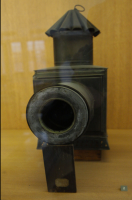








The magic lantern or Laterna Magica is an early type of image projector employing pictures on sheets of glass. It was developed in the 17th century and commonly used for educational and entertainment purposes.
There has been some debate about who the original inventor of the magic lantern is, but the most widely accepted theory is that Christiaan Huygens developed the original device in the late 1650s.In the fifteenth century, however, Giovanni Fontana, a Venetian engineer, had already created a lantern that projected an image of a demon. Other sources credit the German priest Athanasius Kircher, who describes a device similar to a magic lantern in his book Ars Magna Lucis et Umbrae.There are possible mentions of this device associated with Kircher as early as 1646. Even in its earliest use, it was demonstrated with monstrous images such as the Devil.Huygens's device was even referred to as the ""lantern of fright"" because it was able to project spooky images that looked like apparitions.In its early development, it was mostly used by magicians and conjurers to project images, making them appear or disappear, transform from one scene into a different scene, animate normally inanimate objects, or even create the belief of bringing the dead back to life.
In the 1660s, a man named Thomas Walgensten used his so-called ""lantern of fear"" to summon ghosts. Such uses of this early machine were not uncommon. In fact, a common setup of the machine was to keep parts of the projector in a separate, adjoining room with only the aperture visible, to make it seem more magical and scare people. By the 18th century, use by charlatans was common for religious reasons. For example, Count Cagliostro used it to ""raise dead spirits"" in Egyptian masonry. Johann Georg Schröpfer of Leipzig used the magic lantern to conjure up images of spirits on smoke. Schröpfer later went insane, thinking he was pursued by real devils, and shot himself after promising an audience he would later resurrect himself.